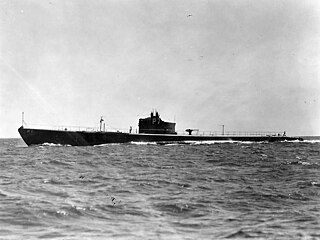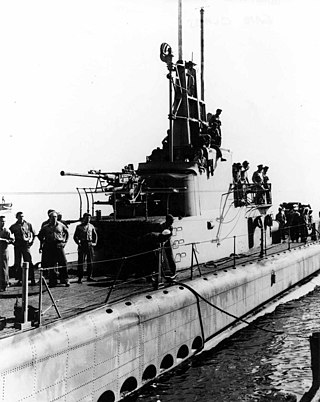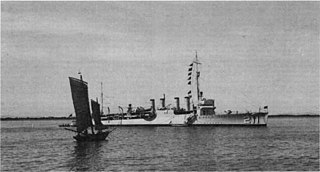
The United States Asiatic Fleet was a fleet of the United States Navy during much of the first half of the 20th century. Before World War II, the fleet patrolled the Philippine Islands. Much of the fleet was destroyed by the Japanese by February 1942, after which it was dissolved, and the remnants incorporated into the naval component of the South West Pacific Area command, which eventually became the Seventh Fleet.

USS Seawolf (SS-197), a Sargo-class submarine, was the second submarine of the United States Navy named for the seawolf.

USS Bonefish (SS-223) was a Gato-class submarine, the first United States Navy ship to be named for the bonefish.

USS Darter (SS-227), a Gato-class submarine, was the first ship of the United States Navy to be named for the darter.

USS Permit (SS-178), a Porpoise-class submarine, was the first ship of the United States Navy to be named for the permit.

USS Harder (SS-257), a Gato-class submarine, was the first ship of the United States Navy to be named for the Harder, a fish of the mullet family found off South Africa. One of the most famous submarines of World War II, she received the Presidential Unit Citation. Her commanding officer throughout her service, the resolute and resourceful Commander Samuel D. Dealey (1906–1944), "a submariner's submariner", was posthumously awarded the Medal of Honor, as well as four Navy Crosses during his lifetime.

USS Tarpon (SS-175), second United States Navy ship of this name, was a Porpoise-class diesel-electric submarine. Tarpon conducted war patrols in the Pacific Ocean during World War II.

USS Skipjack (SS-184), a Salmon-class submarine, was the second ship of the United States Navy to be named after the skipjack tuna. She earned multiple battle stars during World War II and then was sunk, remarkably, by an atomic bomb during post-World War II testing in Operation Crossroads. Among the most "thoroughly sunk" ships, she was refloated and then sunk a second time as a target ship two years later.

USS Stingray (SS-186), a Salmon-class submarine, was the second ship of the United States Navy to be named the stingray.

USS Bluefish (SS-222), a Gato-class submarine, was the first ship of the United States Navy to be named for the bluefish. Between 9 September 1943 and 29 July 1945 she completed nine war patrols. Her operating area extended from the Netherlands East Indies to the waters south of Honshū. According to the notoriously unreliable JANAC accounting, Bluefish sank 12 Japanese ships totaling 50,839 tons.

USS Bream (SS/SSK/AGSS-243), a Gato-class submarine, was the first ship of the United States Navy to be named for the bream. She served during World War II, and her war operations extended from 1 June 1944 to 15 June 1945. During this period she completed six war patrols operating in the Java Sea, Celebes Sea, Sulu Sea, South China Sea, and Gulf of Siam. She sank two Japanese merchant ships totaling 6,934 gross register tons. In addition, Bream shared with the submarines USS Ray (SS-271) and USS Guitarro (SS-363) the destruction of a 6,806-gross register ton passenger-cargo ship. On 23 October 1944, while patrolling off western Luzon, Bream made a daring surface attack on a Japanese naval force, damaging the heavy cruiser Aoba.

USS Gabilan (SS-252), a Gato-class submarine, was the only ship of the United States Navy to be named for the gabilan, an eagle ray of the Gulf of California.

USS Blower (SS-325), a Balao-class submarine, was a ship of the United States Navy in commission from 1944 to 1950. She was named after the blower, a type of pufferfish of the United States East Coast and West Indies. During World War II, She completed three war patrols, all in the Indian Ocean, Java Sea, and South China Sea.

USS Alden (DD-211) was a Clemson-class destroyer of the United States Navy (USN). Serving during World War II, Alden is the only ship of the US Navy to have been named for Rear Admiral James Alden, Jr. (1810–1877).

Kuma (球磨) was a Kuma-class light cruiser in the Imperial Japanese Navy. The lead vessel of the five ship class, she was named after the Kuma River in Kumamoto prefecture, Japan.

Naka (那珂) was a Sendai-class light cruiser in the Imperial Japanese Navy (IJN), named after the Naka River in the Tochigi and Ibaraki prefectures of eastern Japan. Naka was the third vessel completed in the Sendai class of light cruisers, and like other vessels of her class, she was intended for use as the flagship of a destroyer flotilla.

Maya (摩耶) was one of four Takao-class heavy cruisers, active in World War II with the Imperial Japanese Navy (IJN). These were the largest and most modern cruisers in the Japanese fleet, and were intended to form the backbone of a multipurpose long-range strike force. These ships were fast, powerful and heavily armed, with enough firepower to hold their own against any cruiser in any other navy in the world. Her sister ships were Takao, Atago and Chōkai.
Murasame was the third of ten Shiratsuyu-class destroyers, and was built for the Imperial Japanese Navy under the "Circle One" Program. This vessel should not be confused with the earlier Russo-Japanese War-period Harusame-class torpedo boat destroyer with the same name.

Ro-33 was an Imperial Japanese Navy Ro-33-class submarine. Completed and commissioned in October 1935, she served during World War II in the South China Sea, Indian Ocean, and southwestern Pacific Ocean and operated in support of Japanese forces in the invasion of British Malaya, the invasion of Java, the Battle of the Coral Sea, the Guadalcanal campaign, and the New Guinea campaign. She was sunk in August 1942 during her fifth war patrol.


















